The best email marketing software for ecommerce companies has emerged as a must-have investment for many business leaders. As consumers spend more time shopping online, they have countless companies competing for not just their attention, but their loyalty.
Email marketing software provides business leaders with the tools they need to engage potential customers, nurture prospects, and inspire repeat purchases. At the same time, these automated tools can be extremely useful when developing a sense of trust with buyers. Organizations can send emails when a customer makes an order to help them track their purchasing details.
For business owners, connecting with an email list through the right software can make it easier to increase average order value, boost long-term sales, and even encourage customer referrals. Plus, these tools are great for tackling the common issue of “abandoned carts”.
The biggest challenge is figuring out which email marketing software is best suited for the ecommerce landscape. Here are some of the top-rated solutions on the market today.
HubSpot
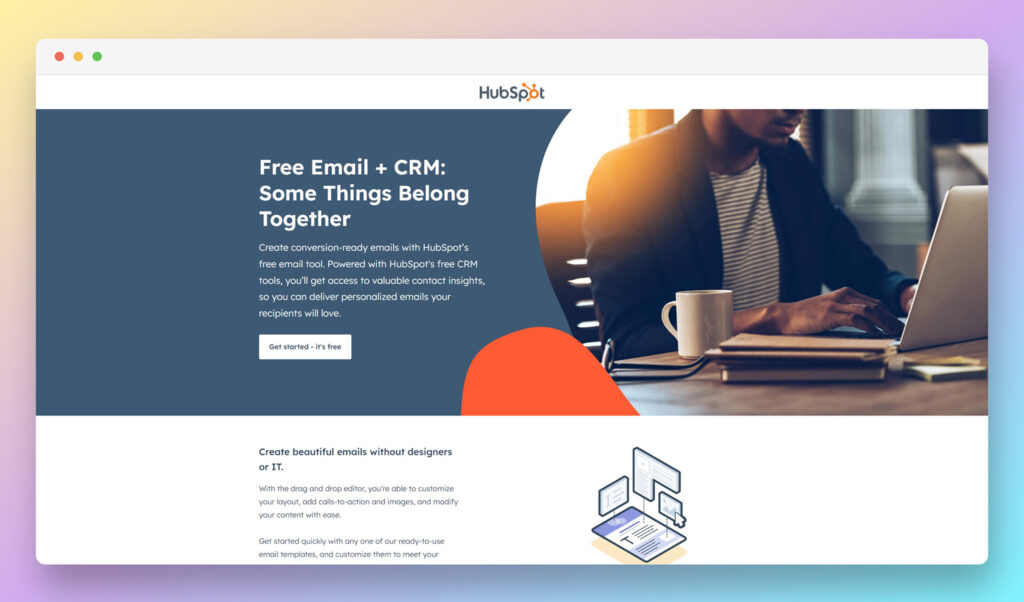
HubSpot offers a unique solution for email marketing for growing ecommerce companies. The all-in-one HubSpot ecosystem comes with a range of packages to support service, sales, and marketing. Within the “Marketing Hub”, there are a collection of marketing tools for email, including free options which integrate with a free CRM system.
HubSpot makes it easy to impress ecommerce customers with beautiful email campaign templates, segmented by goal and industry. There’s also a convenient drag-and-drop editor for customizing your messages. You can personalize your emails based on information about a customer’s lifecycle stage, or details from their contact record. Plus, smart rules make it easy to implement dynamic content.
HubSpot comes with convenient A/B testing functionality to determine which subject lines get the most opens and sales. There’s also a way to dive into reports to see when customers are most likely to connect with your emails, and which emails are the most effective. HubSpot even has a training environment where you can learn more about marketing strategies.
Pricing
You can access the basic features of HubSpot email marketing for free, within the “Free plan” for the Marketing Hub. This plan also includes access to contact management, forms and landing pages, live chat, Facebook, Google, and LinkedIn ads, and contact management.
Advanced packages of the Marketing Hub come with extra marketing automation tools and solutions for creating blogs, SEO campaigns, and omnichannel strategies. Options include:
- Starter: $45 per month for everything in Free plus ad retargeting, multiple currencies, HubSpot branding removal, landing page reporting, and more.
- Professional; $800 per month for the features of Starter, plus Omnichannel automation, SEO, blogging, social media, and custom reporting.
- Enterprise: Starting at $3,600 per month for all the features of Professional, plus account-based marketing, predictive lead scoring, adaptive testing, multi-touch revenue attribution and user roles for your team.
Pros:
- Multi-channel marketing capabilities
- Excellent templates sorted by goal
- Integration with Facebook, Google, and LinkedIn ads
- Free CRM for contact management
- Forms and landing pages included
Cons:
- Higher packages can be quite expensive
- Lots of features to get used to
Sendinblue
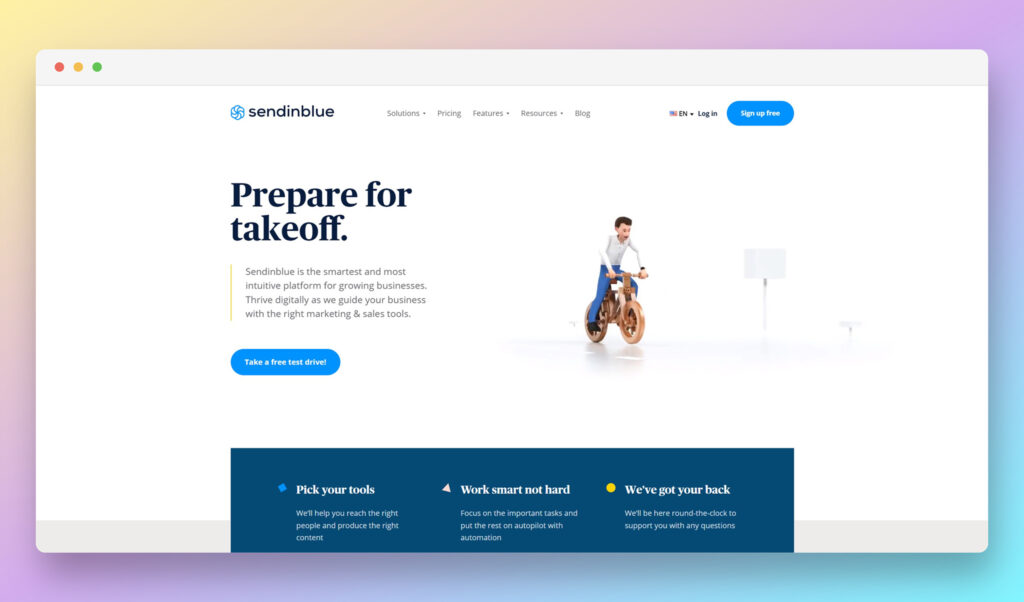
Sendinblue is one of the most straightforward and feature-rich email marketing tools available today. It offers companies an easy way to send professional emails and access advanced features, without spending a fortune. Companies can access built-in CRM capabilities, to help track the relationships they’re building with their target audience. Plus, there are automation capabilities for all kinds of useful messages.
Businesses can instantly recover lost messages by using Sendinblue’s page tracking feature to trigger abandoned cart emails based on subscriber website behavior. There are transaction emails which use Sendinblue’s SMTP server to keep customers up-to-date on the status of their order. Plus, built-in conversion tracking tools make it easy to see which of your marketing efforts are driving the most revenue and engagement.
Sendinblue comes with professional templates business leaders can use to create all kinds of newsletters and content. Plus, you can build subscription forms with lead-magnets to help bring more customers into your community. What’s more, the service integrates easily with tools like Shopify, Prestashop, WooCommerce, and BigCommerce. This means ecommerce brands can easily segment their audience based on customer behavior.
Pricing
There’s a free plan available from Sendinblue which supports unlimited contacts, and up to 300 emails a day. After that, plans start at $25 per month, and all packages include unlimited contact storage. Options include:
- Lite: $25 per month for up to 20,000 emails, no daily spending limit, A/B testing, and email support from the Sendinblue team.
- Premium: $65 per month for 20,000 emails, with all the features of Lite, plus marketing automation, Facebook Ads, landing pages, multi-user access and telephone support.
- Enterprise: Custom pricing for custom email volumes, priority sending, more than 20 landing pages, access for over 10 users, SSO (SAML) and a customer success manager.
Pros:
- Integrations with a range of ecommerce tools
- Automated workflows for abandoned carts
- Excellent segmentation for personalized messages
- Landing pages and contact capture forms
- Affordable pricing packages
Cons:
- Limited free plan
- Missing some advanced features
Klaviyo
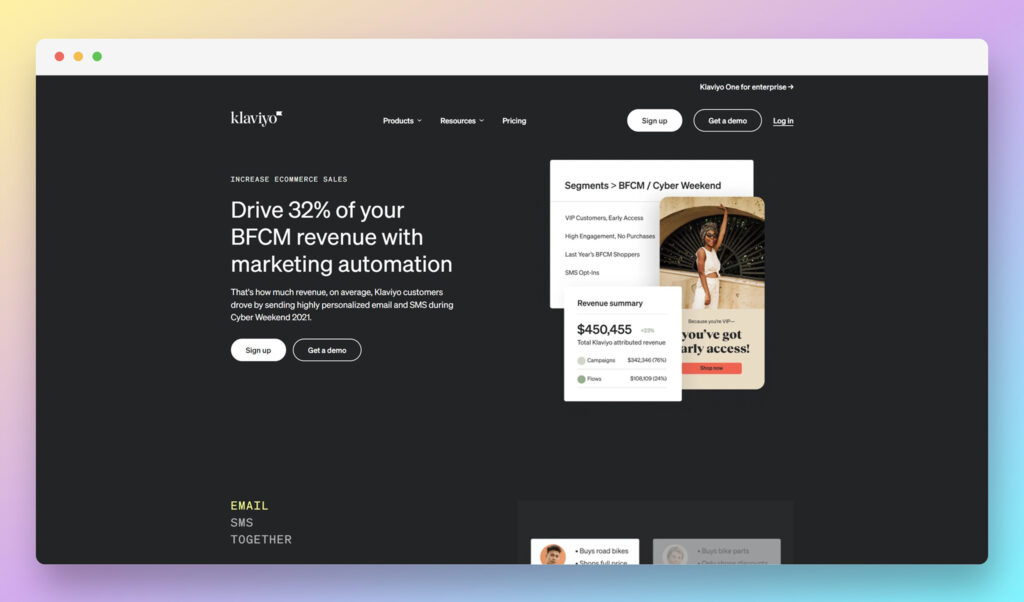
Klaviyo is a popular email marketing software designed specifically to support ecommerce companies. It’s one of the leading platforms for users of the Shopify ecosystem, with more than 50,000 stores using the integration. All of the features on the platform are designed to increase repeat sales, maximize revenues, and improve audience retention.
Klaviyo makes it easy to send quick and effective personalized emails to audience members based on their browsing activities, previously viewed products, abandoned carts, or items ordered, among other factors. There are also tools for driving repeat sales with automation. For instance, you can design cross-selling campaigns, and update customers automatically when a price drops.
Pre-built templates from Klaviyo also make it simple for beginners to get started with custom marketing campaigns. You can send exclusive product announcement emails to VIPs, discount emails to shoppers in search of a bargain, and newsletters based on product line or location. Perhaps most importantly, the tool also integrates with a range of ecommerce platforms, such as Shopify, Magento, Salesforce, PrestaShop, WooCommerce and BigCommerce.
Pricing
Pricing for Klaviyo is based on the number of contacts you have, and whether you want to use both email and SMS, or email on its own. There’s a free plan which allows for users to send up to 500 monthly emails to 250 contacts. This package also includes email and chat support, and 150 SMS/MMS credits to use per month. Other packages include:
- Email: Starting at $20 per month for up to 500 contacts and 5000 monthly email sends, as well as 150 SMS/MMS credits, and email/chat support.
- Email and SMS: Starting at $35 per month for up to 500 contacts, email and chat support, and 5000 monthly email sends, with 1,250 SMS/MMS monthly credits.
Pros:
- Integrations with a range of ecommerce tools
- Flexible and free pricing options
- Built-in forms, templates, and automations for contact nurturing
- Excellent customer personalization options
- SMS marketing options built-in
Cons:
- Slightly more complex than other tools
- Limited number of contacts on some plans
ConvertKit
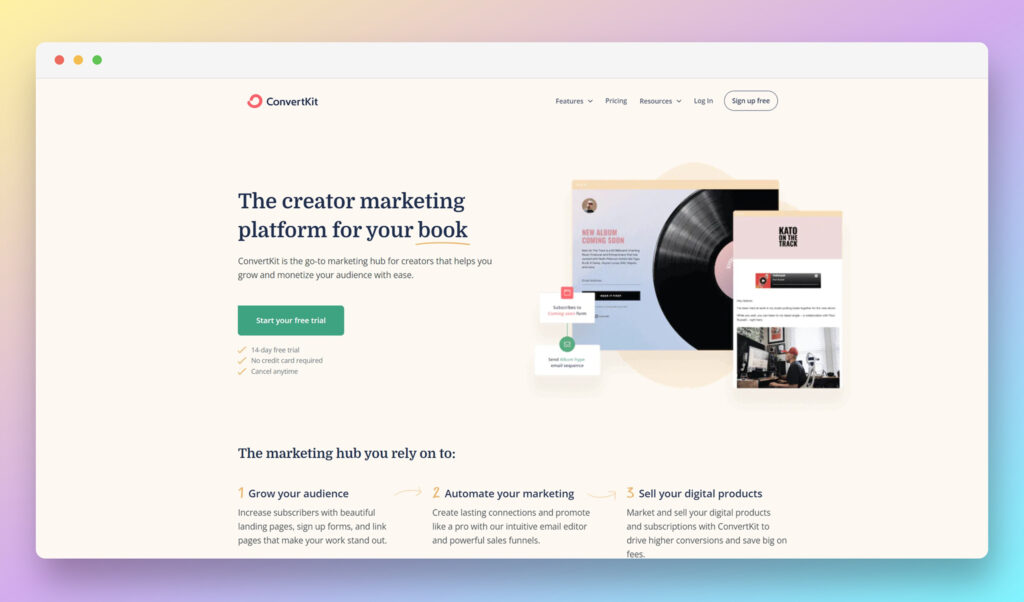
Committed to making email marketing quick and simple for ecommerce owners, ConvertKit is one of the most popular tools out there. ConvertKit even has tools for selling products through your own dedicated pages online, making it ideal for smaller companies and creators.
The features of ConvertKit are fantastic for business leaders. There are landing pages and email signup forms to help collect lists of potential contacts for a campaign. Plus, the included email designer is fantastic for building your own branding into every message. The email marketing templates are attractive and easy to use, with no coding required.
ConvertKit’s automation features are also particularly impressive, with pre-build and custom paths to choose from to help with everything from recovering abandoned carts, to sending transaction emails. You’ll also be able to tag and segment your audience to make sure you’re sending the right messages to the correct people. Companies can even integrate their ecommerce tools, such as Shopify, WooCommerce, and Teachable into their automation environment.
Pricing
Like many popular email marketing tools, ConvertKit adjusts its pricing based on the number of contacts or subscribers you have. There’s a free plan for up to 300 subscribers, which includes unlimited email broadcasts, forms, and landing pages. You also get community support, options for selling digital products and subscriptions, and audience segmentation. Paid plans include:
- Creator: Starting at $9 per month for up to 300 subscribers with all the features of “Free”, plus free migration, visual automation builders, automated email sequences, one additional team member and third-party integrations.
- Creator Pro: Starting at $29 per month for up to 300 subscribers with all the features of Creator, plus a newsletter referral system, unlimited team members, subscriber scoring, and advanced reporting.
Pros:
- Clean and easy-to-use interface for beginners
- Unlimited email sending options
- Easy-to-use automation builder
- Drag-and-drop editor for emails and landing pages
- Audience tagging and segmentation
Cons:
- Some limitations on the basic packages
- Integrations can be basic
MailerLite

MailerLite is a powerful, yet easy-to-use tool for ecommerce email marketing. The simple and straightforward interface makes it easy to track and connect with your valued customers with engaging email templates. You can connect online stores directly, thanks to integrations with tools like Shopify and WooCommerce, and sync your data to your email campaigns.
It’s also possible to import products directly from the ecommerce platform with customizable product email blocks. This is great for abandoned cart emails and personalized marketing messages. The drag-and-drop editor also makes it easier to create stunning messages in no time, whether you’re sending transactional emails or marketing emails.
MailerLite includes CRM technology for tracking audience data, as well as in-depth reporting and analytics tools, so you can see how messages influence your bottom line. There’s a free landing page builder, and pop-up creation tool to help you reach new customers, and powerful marketing automation flows for reaching people at the right time. Plus, you can trigger emails based entirely on a customer’s purchasing behavior.
Pricing
The cost of your MailerLite subscription will depend on which package you choose, and how many subscribers you have. The free plan supports up to 1,000 subscribers and 12,000 monthly emails for a single user, with email support. There’s access to 10 landing pages, signup forms and pop-ups, website creation, and automation too. Paid plans include:
- Starter: Starting at $9 per month for unlimited monthly emails to up to 1,000 contacts, access for 3 users, and unlimited templates. You can also send dynamic emails, auto resend campaigns, build unlimited websites, and create an unsubscribe page.
- Advanced: Starting at $19 per month for 1,000 subscribers for all the features of Starter, plus upgraded customer support, a Facebook integration, promotional pop-ups, multiple automation triggers, preference centers, and a custom HTML editor.
- Enterprise: Custom pricing for people with more than 100,000 subscribers with all the features of Advanced. You also get a dedicated success manager, IP and delivery consultations, custom newsletter, and landing page designs.
Pros:
- Included CRM for tracking customer data
- Easy automation building and multiple triggers
- Free landing page builder and pop-ups
- Easy to use drag-and-drop editor
- Valuable features like dynamic emails
Cons:
- May be too basic for some larger companies
- Limited free plan
Omnisend
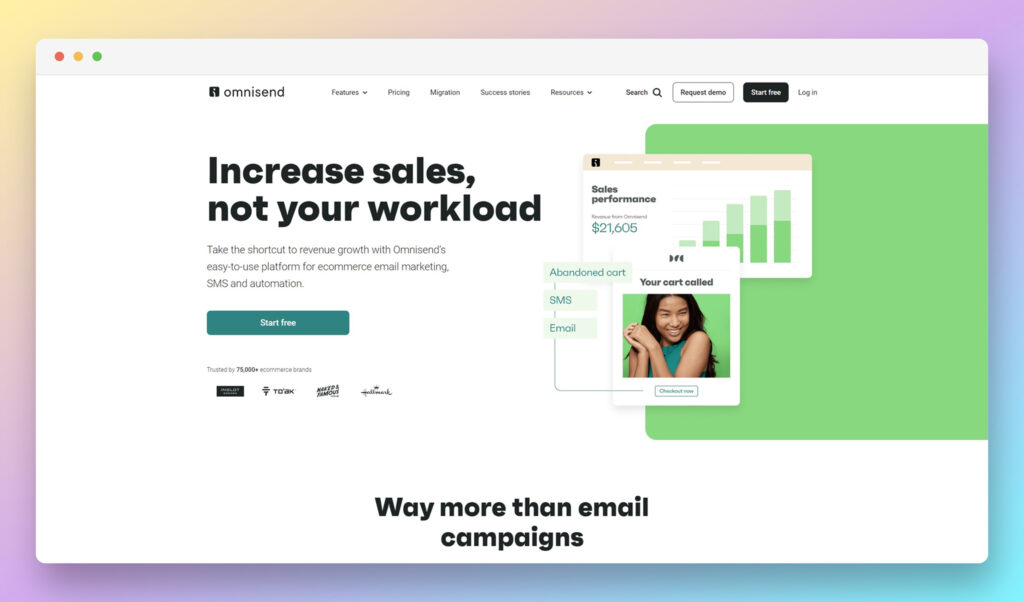
Omnisend promises to increase ecommerce sales without increasing the workload of a standard business owner, with easy-to-use email and SMS automation. The tool allows for the creation of automated and segmented emails and SMS messages, with completely customizable templates. The in-built automations are excellent for dealing with things like welcome series and abandoned cart messages. Plus, you can A/B test each campaign you send.
Omnisend supports excellent segmentation of customers too, with the ability to track customers based on their campaign actions, shopping behavior, and more. You can choose ready-made subject lines, messages, and workflow settings, to start connecting with customers straight away. Or you can use the drag-and-drop editor to customize your content.
Omnisend allows for dynamic email creation and coupon codes, automatic product picking, fully customizable pop-ups, and unique push notifications for SMS. You can sync your audience with Google and Facebook, and integrate your email system with Shopify, Wix, BigCommerce, and WooCommerce. Plus, thorough analytics make it easier to track everything from sales to campaign performance and unsubscribe rates.
Pricing
Pricing for Omnisend starts with a free plan available for up to 250 contacts per month. You can also send up to 500 emails and 60 SMS messages per month, alongside 500 web push notifications. The free plan includes templates, pre-built automations, unlimited segmentation, A/B testing, sales reporting, and customer support via email.
Paid packages increase in price based on the number of subscribers you have. Your two options for 500 contacts start at:
- Standard: $16 per month for up to 6,000 emails per month, 60 SMS messages, and unlimited web push messages. You also get all the features of free, 24/7 chat support, and a customer success manager if you have more than 60k contacts.
- Pro: $59 per month for unlimited emails, up to 3,993 SMS messages and unlimited web pushes per month. You also get everything in Standard, plus advanced reporting, a customer success manager from 27k contacts, and 24/7 priority support
Pros:
- Excellent email customization with drag-and-drop builder
- SMS and push notifications
- Pre-built automations and workflows for ecommerce
- Fantastic analytics and reporting features
- Integrations with leading ecommerce tools
Cons:
- Slight learning curve for beginners
- Pricing can be a little high on some packages
Mailchimp

Anyone searching for an email marketing platform is probably familiar with Mailchimp. Well-known for it’s ability to simplify complex email marketing campaigns, Mailchimp combines a range of powerful tools, with an intuitive backend for small businesses. The company was also recently acquired by Intuit, making them an excellent choice for ecommerce brands.
Mailchimp can help any ecommerce store to set up an attractive, and professional-looking email automation strategy in no time. There are plenty of options for segmenting your contact list, so you can ensure you’re sending the right messages to the correct customers. Plus, you can set up simple autoresponders for cart abandonment, cross-selling, up-selling and more.
MailChimp’s simple email builder uses drag-and-drop functionality to allow companies to customize their campaigns with their own branding. Plus, the automation system means you can ensure your follow-up emails and transactional emails to arrive in your customer’s inbox at a time most likely to encourage high open rates. On top of all that, Mailchimp also offers real-time SMS marketing and integrations with tools like WordPress (WooCommerce), Shopify, and Squarespace.
Pricing
There’s a free package available from MailChimp for companies sending up to 2,500 emails per month. This plan allows for 500 contacts, 1 user, and email support for 30 days. You also get access to hundreds of integrations, forms and landing pages, analytics and reporting tools, templates, and a creative assistant for building your emails. Other plans include:
- Essentials: Starting at $11 per month for up to 500 contacts and 5000 monthly email sends, 3 users, and 24/7 support. You get all the features of Free, plus role-based access, the option to remove MailChimp branding, A/B testing, email scheduling, and automation.
- Standard: Starting at $17 per month for 500 contacts and 6,000 emails, as well as 5 users, and all the features of “Essentials”. You also get enhanced automation, pre-built journeys, custom templates, predictive segmentation, sent time and content optimization, and dynamic content.
- Premium: Starting at $299 per month for up to 500 contacts and unlimited emails, as well as unlimited users and all the features of Standard. Extra features include multivariate testing, comparative reporting, advanced segmentation and a dedicated onboarding specialist
Pros:
- Plenty of customizable templates
- Tracking and reporting for click-through rates and opens
- Integration with digital marketing tools
- Great ease of use and deliverability
- Excellent intelligent customer segmentation
Cons:
- Lacking some advanced features in early plans
- Some templates can be a bit basic
Moosend
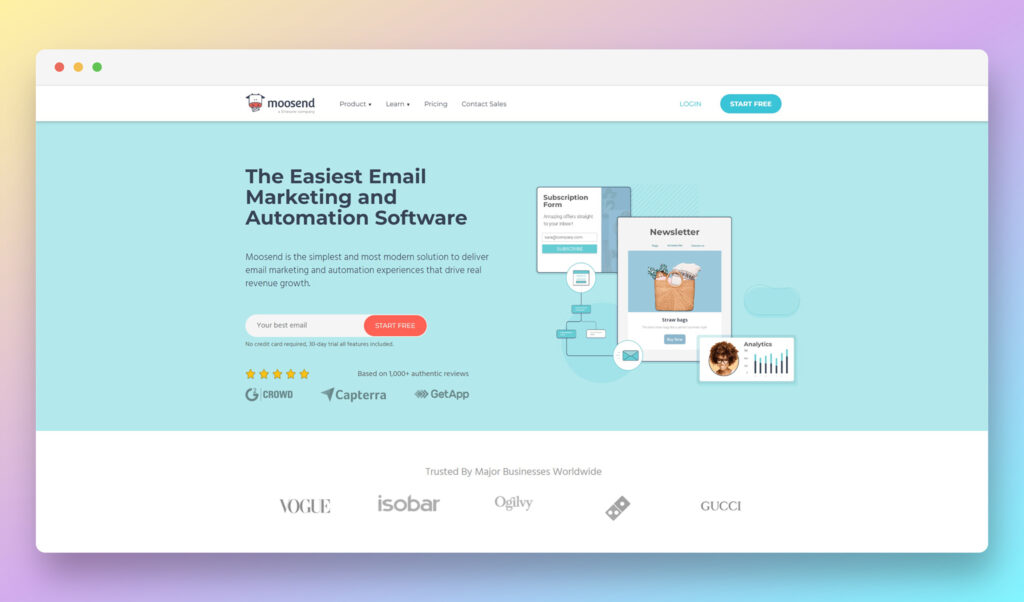
Another fantastic option for sending email newsletters to ecommerce customers, Moosend is a popular software solution packed full of marketing features. This user-friendly service offers high speed and excellent deliverability for minimum effort. You can create powerful cart abandonment emails, and automated newsletters to boost your chances of sales. You’ll even be able to send emails based on factors like the weather.
Moosend has a host of automation features to choose from, ideal for cross-selling, replenishment emails, product recommendations and more. You can also customize all of your email templates however you choose with an easy building system. Built-in tracking and reporting features also make it easier to examine the behavior of your customers as they move through your site and interact with your emails.
Thanks to powerful integrations with your website builder, Moosend can give you a comprehensive view of the customer journey, from start to finish. The solution also comes with a fantastic user interface, which takes minimal time to learn, even for complete beginners. Plus, the service integrates with other digital marketing tools like GetResponse, and Salesforce.
Pricing
There’s a free trial available for Moosend which gives you 30 days of access to everything but the company’s SMTP server. After that, there’s only two pricing options to choose from, available on either a monthly or annual plan. The “Pro” plan starts at $9 per month for up to 500 subscribers and increases in price the more contacts you have. However, it includes unlimited emails, automation, landing pages and forms, and SMTP server access.
The Enterprise plan is available via a custom quote from the company, and includes all of the features of the Pro plan, plus your own dedicated account manager, SSO and SAML, a dedicated IP, and priority support.
Pros:
- Templates for promoting everything from sales to webinars
- Easy-to-use interface for beginners
- Excellent tracking and reporting features for multiple metrics
- Huge range of integration options and API access
- Convenient email editor
Cons:
- No free email marketing services
- May have a small learning curve
Choosing Email Marketing Services For Ecommerce Businesses
There’s no one-size-fits-all strategy when it comes to choosing the best email marketing tool for ecommerce companies. All of the options mentioned above, as well as other popular options like Drip and ActiveCampaign, and Constant Contact come with their own pros and cons to consider.
The right option for you will depend on the features and functionality you need, as well as which ecommerce tool you’re using. Keep in mind, many of the top email tools have integrations with website builders, or their own dedicated plugin for certain app markets.
Where possible, it’s definitely worth checking out some free trials before you sign up for your ideal email marketing tools, so you can test the features before you start spending.




Comments 0 Responses